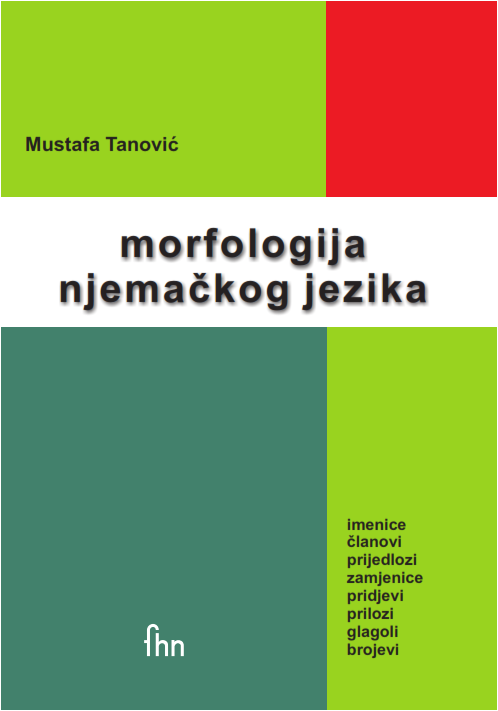
We kindly inform you that, as long as the subject affiliation of our 300.000+ articles is in progress, you might get unsufficient or no results on your third level or second level search. In this case, please broaden your search criteria.

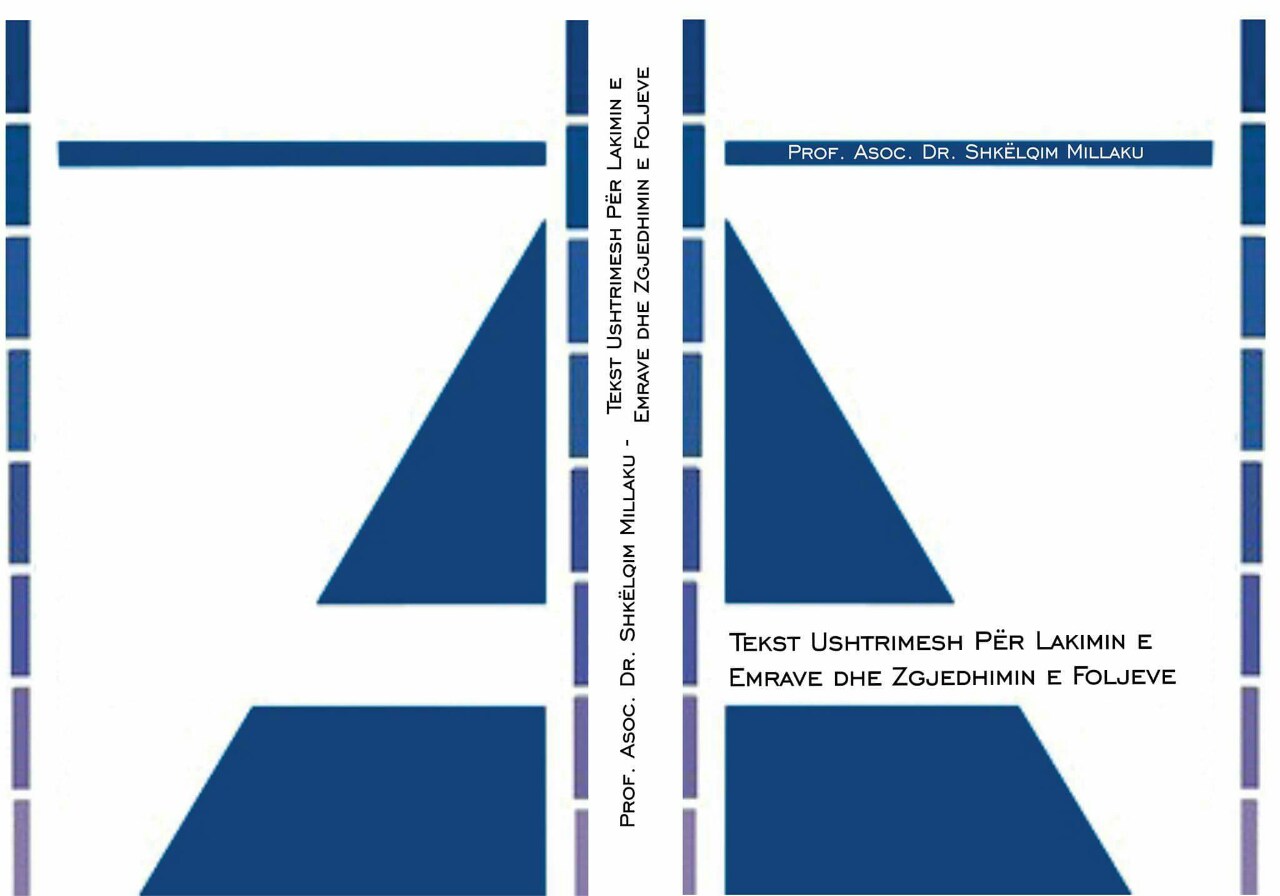
The book “Tekst ushtrimesh për lakimin e emrave dhe zgjedhimin e foljeve” has two chapters. The first chapter has some nouns, adjectives, pronouns that are presented in practice. In the second chapter has all for the verbs. All the curvature and conjugation are without theory. All of them are in practice.
More...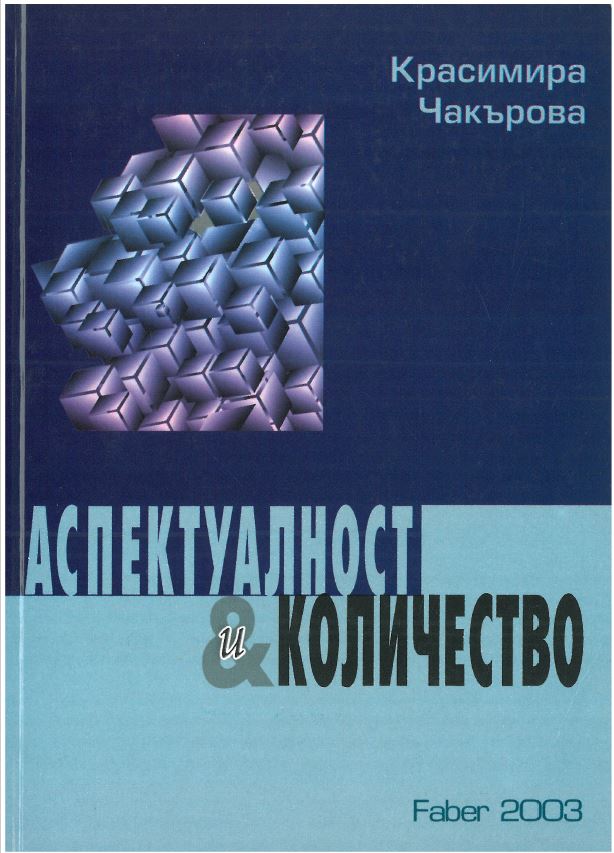
The subject of the scientific analysis in the present book is the paradigm of the language means used for expressing verbal quantity. The book presents cogent arguments as regards the existence of a genetic, typological and formal disparity among the quantitative systems of nouns, adjectives and numerals in comparison to the one of verbs, on account of which the study subsequently discards the popular concept of the hyper-categorial nature of quantity. The book presents a new model of the different types of aspectual relations in the Modern Bulgarian language. The Verbal Aspect is interpreted as a three-member category, formed as a result of the complex interactions between the separate functional-semantic fields in the area of Aspectuality.
More...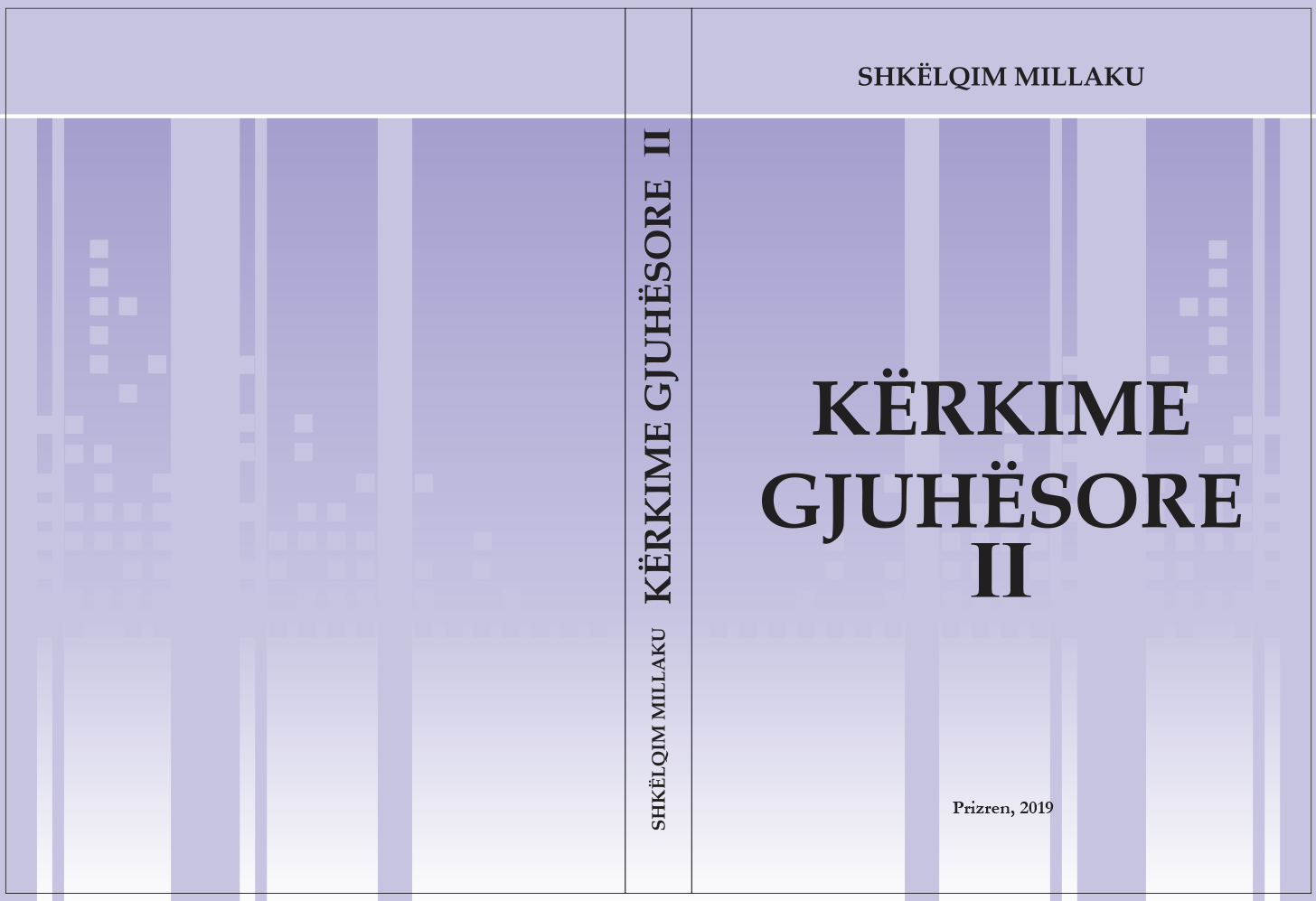
The book “Kërkime gjuhësore II” has two chapters: In the first chapter are researches for compound words. All the compound words are founded by journal “Përpjekja shqiptare”. The compound words are all the words that are compound from two or more words and both of them creative the new words with the new meaning. In linguistics, a compound is a lexeme (less precisely, a word) that consists of more than one stem. Compounding or composition is the word-formation that creates compound lexemes (the other word-formation process being derivation). Compounding or Word - compounding refers to the faculty and device of language to form new words by combining or putting together old words. In other words, compound, compounding or word-compounding occurs when a person attaches two or more words together to make them one word. The meanings of the words interrelate in such a way that a new meaning comes out which is very different from the meanings of the words in isolation. The second chapter has some papers: Pikëpamjet e Idriz Ajetit për nyjën e shqipes; Studim krahasues i nyjës së prapme të shqipes dhe gjuhëve ballkanike; Ndihmesa e Stuart Edward Mannit për gjuhën shqipe
More...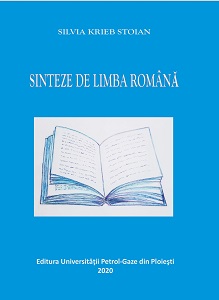
Sinteze de limba romȃnă is an overview of the new approach to Romanian grammar. It is a descriptive grammar updated in conception and terminology. Two modern grammars serve as a basis for the present book: the new Academic Grammar of Romanian (GALR, 2005) and Basic Romanian Grammar (GBLR, 2010). The book highlights the most important conceptual and terminological innovations and consists of two parts. The first one describes the lexical-grammatical classes and the second one presents the syntactic positions introduced in GALR (prepositional object, secondary object, object complement, possessive object, comparative complement).
More...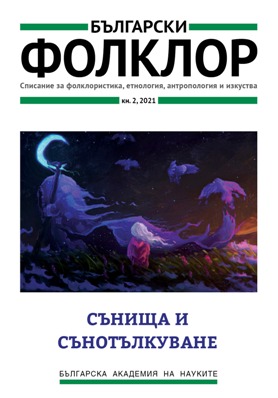
The study analyses texts that refer to dreams, excerpted from biblical, Medieval Bulgarian, literary and folklore works, and from fieldwork material collected personally by the author. The text reveals the most important features of the narrative in the dream, such as models, language formulas, and strategies for representing time. The analysis of the dream-book’s language demonstrates that today the dream-book is designed as a dictionary with its own vocabulary list and specific rules for constructing the interpretive definition, which include semantic, lexical, morphological, and syntactic laws.
More...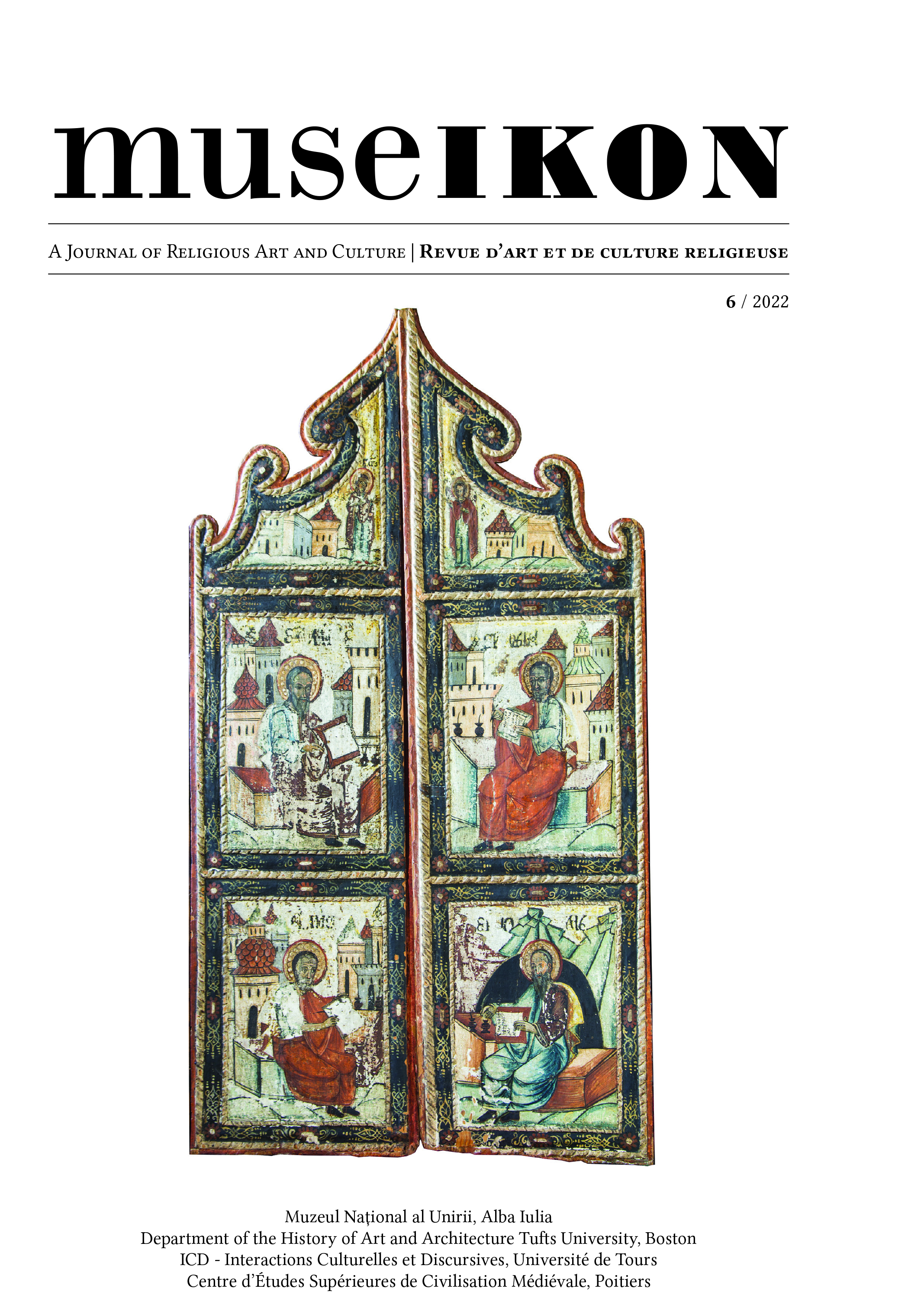
Après avoir reconfirmé la datation de Camille Enlart (vers 1421 ou 1421-1424) et identifié le comman-ditaire (l’évêque de Limassol Barthélemy Gui) dans une inscription fragmentaire, la présente étude explore: d’une part, les modèles des inscriptions en langue vernaculaire française de Pyrga (Chypre); d’autre part, la lo-gique du programme iconographique et le contexte culturel que sous-tend cette dernière. Dans la première par-tie, l’analyse des inscriptions de la chapelle prouve que le concepteur du décor peint a suivi un modèle manuscrit, sans doute un psautier avec un grand cycle d’enluminures. L’étude évoque trois termes de comparaison célè-bres: le Psautier de la reine Ingeburge (Chantilly, Bibliothèque du Musée Condé, 9 – tournant du xiiie siècle), le psautier de l’évêque Henri de Blois (Londres, British Library, Cotton Nero C iv – vers 1160) et le livre d’images de Marie de Rethel (Paris, Bibliothèque nationale de France, n. acq. fr. 16251 – vers 1285). Dans la source manuscrite reconstituée, les inscriptions en ancien français étaient probablement transcrites en tant que tituli, d’après une typologie tripartite: noms de fêtes religieuses, groupes nominaux ayant une fonction analogue et légendes sous forme d’énoncés introduits par l’adverbe coument. La langue des inscriptions de Pyrga, un français d’Outremer, présente les traits particuliers des scriptae chypriotes de la fin du Moyen Âge. De plus, on constate que la déco-ration de la chapelle inscrit le monument de Pyrga dans la catégorie des chapelles royales de l’Europe occidentale (xive et xve siècles). Le transfert du codex à la paroi concerne non seulement les images, mais également les textes qui accompagnent ces dernières. L’auteur s’intéresse ensuite à la disposition symétrique de la décoration dans les deux travées de la chapelle, ainsi qu’à la manière dont cette disposition accentue l’Uniatisme catholique-orthodoxe. La logique dos-à-dos de la décoration émule celle des icônes à double face – termes de comparaison directs pour la chapelle – notamment leur choix d’apparier deux scènes : la Crucifixion / la Mère de Dieu. Le con-cepteur du décor peint souhaitait évoquer l’osmose de deux églises: une église latine, orientée vers l’Est; la sug-gestion d’une église byzantine, orientée vers l’Ouest. Cela explique le choix particulier de la décoration des voûtes (christologique pour la travée Est et mariale pour la travée Ouest), la double représentation de l’An-nonciation (pour marquer l’orientation des deux églises) et le choix d’une composition de type pala d’altare pour la paroi Est, tandis que la paroi Ouest imite la décoration des templons byzantins. L’osmose des deux églises est indiquée de manière encore plus claire par le choix de représenter les martyriums des saints Étienne (signifiant l’Orient) et Laurent (signifiant l’Occident) au-dessus des entrées latérales. Ce serait une allusion à l’osmose des corps de ces saints dans la Coniunctio corporum sanctorum Stephani et Laurentii (bhl 4784b). Après une réévaluation du texte fragmentaire (aujourd’hui perdu) de l’inscription dédicatoire, il est évident que la dédicace proprement dite concernait l’Assomption de la Vierge. Qui plus est, l’osmose Est-Ouest était de nou-veau indiquée par la représentation dans un même cadre de la Dormition de la Mère de Dieu (sujet à connotation byzantine) et du Couronnement de la Vierge (thème occidental par excellence). Les textes littéraires des xive et xve siècles confirment la fixation chypriote de l’appariement de la Mère de Dieu avec la Passion du Christ, de même que plusieurs autres choix de la décoration de Pyrga. La signification de la décoration devait être multiple, en rapport avec la triple utilité du bâtiment: chapelle funéraire (pour Barthélemy Gui), chapelle royale (pour le couple Janus de Lusignan-Charlotte de Bourbon) et point d’entrée au monastère de Stavrovouni, qui hébergeait des reliques de la Sainte Croix.
More...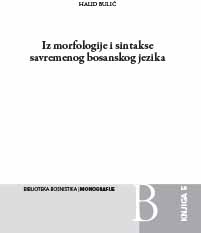
The papers published in this book deal with various issues in contemporary Bosnian syntax and morphology. The paper Types of Nominal Complements of the Verb in Bosnian defines a complement as a clause element and provides a categorization of nominal complements of the Verb in Bosnian The Introduction presents the term complement as it is presented in Bosnian, Croatian and Serbian grammar books After the presentation of different linguistic approaches to the term, the author decides to take the approach offered by the German linguist Ulrich Engel According to his definition, complements are clause elements typical for the Verb subclass, which cannot be used with just any verb, and obligatory elements necessary for grammaticality of the clause Using this definition in this study, we have found out that nominal complements can form three types of relations with the Verb They can be the Subject, the Predicative Nominal or the Object The Subject is a nominal or nominalized word in the Nominative case which is not a part of the Predicate It has a person and number concord with the Predicate Hence, the Subject and the Predicate influence one another and this property makes it different from all other complements The Predicative Nominal is different from the Subject and the Object in the fact that it complements the verb and functions as a part of the Predicate Predicatives are found in different forms in Bosnian: nominal and adjectival in the Nominative and the Instrumental case, numerals, congruent phrases in the form of prepositionless Genitive, Nouns in the oblique case with a preposition which attribute a property to the Subject, the structures with kao or structures with a Finite Verb form, za+Accusative and za+Infinitive structures, prepositions, the Infinitive and the Vocative. This is the first paper which mentions the possibility of having a Vocative in Predicative function (which is not in oral poetic tradition and used differently than in oral tradition), and that the Vocative is a part of the sentence structure Some words in Bosnian can be used only predicatively. In some papers they are called copular particles We believe that these words are either Adjectives or Adverbs Not all the above listed forms which can be used predicatively can be regarded as Predicative Nominals We believe that Predicative Nominals include only nominal predicative complements,which can be in the Nominative, the Instrumental, the Vocative case or the Accusative with the preposition za and the structures with kao.
More...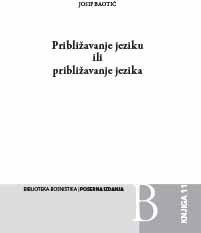
The book Approaching Language is a selection of articles or parts of articles of the author written during his research and teaching work, and in which,sometimes in a great amount, was reported something new, unknown in the Bosnian-Herzegovinian linguistic science until they appeared, whether we consider language as a structural creation, or if we consider it as a social phenomenon.The introductory text – the interview, In the Defense of the Scientific Approach to Language problems, which gives an insight to the author’s relation toward the facts and questions which he clarifies, is first followed by the articles in which the language structure is explained, in the basis of the organic idioms of the štokavian dialect, but of the standard Croatian-Serbian language as well, its nature and norm before the dissolution on separate standard languages: Bosnian, Montenegrian, Croatian and Serbian,then by the texts with theoretical characteristics, dedicated to the questions of language planning and functioning of the standard language in nationally non-homogeneous communities.The problems of organic idioms are very present in this book. Seven works are dedicated to this issue, five of which are related to the most archaicorganic idiom in Bosnia and Herzegovina – the subdialect of the natives in Bosnian Posavina. The first of them, A Contribution to the Problems of the Posavian Ikavian Dialect in Bosnian Posavina, is important because it completed the gap that remained after the monograph of S. Ivić Today’s Posavian Subdialect.This article precisely determines where the southern border of that subdialectin Bosnia and Herzegovina is, and all the villages with the Croatian population that belong to that subdialect are enumerated. The second paper The Syntax of Case in the Subdialect of the Natives in Bosnian Posavina,is the first work describing our dialects that gives a full description of the syntax of case, as a system of constructions used in one subdialect to state all the case meanings.The third work, The Acute Accent in the Subdialect of the Natives in Bosnian Posavina, is a part of the author’s MA paper The Accent System of Village Kostrča in Bosnian Posavina (Bosnian-Herzegovinian Dialectology Anthology II, 159–234). In this article there is a review of the distribution of the acute accent and the author highlighted the grammatical categories in which S. Ivić in his work A Contribution to the Slavic Accent gave arguments for the presence of the acute, and he also mentioned the categories which hadn’t been explained before. The work Orientalisms in the Subdialect of the Natives in Bosnian Posavina is the introductory fraction of the dictionary with the same title. As an introductory text, it talks about the adaptation of the orientalisms in this subdialect, and it is included to complete the totality about this organic idiom, together with the paper About the Subdialect of the Natives of Bosnian Posavina.
More...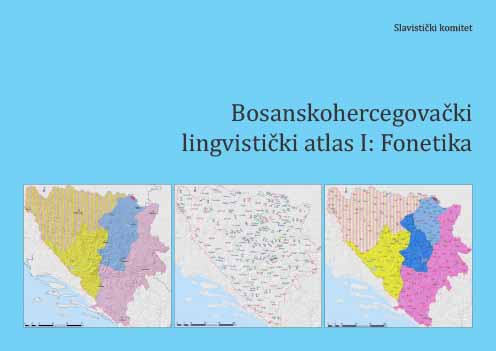
Speech within the borders of Bosnia and Herzegovina falls within four sub-dialects of the štokavian dialect: Eastern Bosnian, Eastern Herzegovinian, Posavinian (or Slavonian) and Western.Two of them are non-novoštokavian (Eastern Bosnian and Posavinian) and two are novoštokavian (Eastern Herzegovinian and Western). Eastern Bosnian is ijekavian šćakavian, Eastern Herzegovinian is ijekavian štakavian, Posavinian is ikavian-jekavian štakavian, and Western isikavian štakavian-šćakavian. Two novoštokavian sub-dialects cover approximately two thirds of the territory of Bosnia and Herzegovina, and two non-novoštokavian cover one third, with the Posavinian sub-dialect covering the smallest territory: only seven villages in the Orašje municipalitys peak in this dialect. Eastern Bosnian and Western sub-dialects are spoken by Bosniaks and Croats, Serbs to a lesser extent; Eastern Herzegovinian is spoken by Bosniaks, Croats and Serbs; Posavinian is spoken by Croats only. Traces of the old division of the štokavian dialect into eastern and western variants is still evident in the speech varieties in contemporary Bosnia and Herzegovina: some reflect features of western štokavian origin, and some of the eastern štokavian. Frequent migrations and mixing of the population of different dialects contributed to the diversity of speech across the country. Moreover, with a pronounced religious and ethnic blending of the population, the dialects in Bosnia and Herzegovina are quite interesting.Scholarly literature on dialectology presents basic information about speech in Bosnia and Herzegovina.However, neither major monographs nor various contributions in the field of dialectology produced from the end of the 19th century onwards offer a view of linguistic phenomena in speech in Bosnia and Herzegovina as a whole – only linguistic atlases provide the geographic spread of certain phenomena in the given language coverage. Systemic linguo-geographic study of BiH speech has been made possible thanks to the material obtained through uniform questionnaires developed as part of the project entitled “BiH Dialectological Complex – Synchronous Description and Position of the Contemporary Standard Language” by the Language Institute in Sarajevo. The BiH Language Atlas (BLA) is based primarily on this corpus, collected throughout 1970s and 1980s. Field research continued in 2016 and 2017 with amendments to some of the questionnaires and the collelction was expanded by recordings from four previously unexplored speech varieties; BLA thus covers 230 local speech varieties. Speech by Bosniaks was researched in one hundred locations, speech by Serbs in eighty, and speech by Croats in fifty. Although speech has been changed considerably, due to movement and relocation of the population during the war in the early 1990s, materials collected between 1975 and 1986 and those from 2016 and 2017 are comparable and create a whole that allows for the production of a national linguistic atlas.The phonetic volume of BLA is the first in a series of volumes planned to be published, and itis the fruit of labour of more than thirty collaborators of the Slavic Committee. The introductory part presents key information about the project itself, a list of speech varieties examined,a list of orthographic markings of speech varieties covered, a list of field researchers with the number of questionnaires completed, a phonetic transcription system, a register of lexemes and a map of dialects and sub-dialects in Bosnia and Herzegovina. The main part is dedicated to themost important phonetic phenomena: of a total of 181 questions, 63 relate to vocalism and 118to consonantism. It contains transcribed recordings of speech varieties examined, a linguistic interpretation of the material, commentaries regarding the ethymology of the lexemes and maps with symbols representing the corpus, allowing th tracking of isophones, determination of areal features of certain phenomena, specification of dialect boudnaries and an overview of horizontal spread of BiH dialects. Each map includes a legend and data on the presence of specific forms with graphic representation. The lettering is in three colours (green: examined speech by Bosniaks;blue: speech by Croats; red: speech by Serbs) in order for the maps to reflect at the same time the differences based on the informants’ ethnic background. The annex present a word index,a list of cited bibliography, as well as a list of abbreviations, markings and graphic symbols.
More...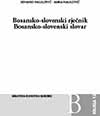
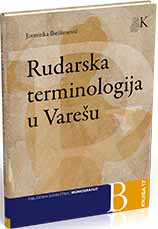
Vareš is a small town near Sarajevo, a synonym for a mining town and a hard way to make one’s living. I started the collection and lexicographic processing of mining terminology from the Vareš region with the goal to„save“ from oblivion the phrases which are going out of use, since mining production in Vareš has stopped entirely.The introductory part of the paper is concerned with the relation be-tween lexis and terminology, with the historical background of mining in Bosnia and Herzegovina and Vareš, as well as the influence of the Saxon miners on mining in Vareš. That part of the paper traces the evolution of mining and with it the evolution of mining phrases, during a specific time period. The main part deals with the influence of ijekavskošćakavski dialect (Eastern Bosnian dialect) on the speech of Vareš miners. The descrip-tions are given of specific aspects of mining terminology at the phonetical-phonological, morphological and lexical levels; there were no significant discrepancies observed at the syntactic level.At the phonetical-phonological level there is an observed tendency to reduce two affricate pairs to jus tone, as well as hyperjekavisation, and tendencies contrary to hyperjekavisation, reduction of consonant clusters, assimilation of vocals, omission of assibilation, etc. At the morphological level,most distinctive qualities werefound in nouns; there were no significant peculiarities to be found in adjectives, verbs and other parts of speech. At the lexical level, a great number of synonyms were found among the collected phrases. The evolution of the mining terminology can best be traced precisely at the lexical level. Certain old phrases are also being used with new meanings.A separate part of the paper is a dictionary with 945 entries. All of them have been thematically classified. Based on research, it was concluded that there is a relatively small number of phrases relating exclusively to mining among the phrases described, and that there are many more generally used phrases and phrases which are used both in mining and other economic activities.
More...
Bosnia and Herzegovina is one of the countries that officially use more than one language, and therefore, as many as three languages have been declared official – Bosnian, Croatian, Serbian. These languages are so related and similar to one another that communication among their users goes on quite smoothly, but for the official purposes, numerous documents undergo the process of adaptation to each of these three languages . Thus,legislative and legal documents are published, i.e. laws, decrees, resolutions, rules, regulations, statutes, etc., and each of these documents has three language versions: Bosnian, Croatian, and Serbian. The subject of this study is a linguistic analysis of legislative and legal documents in Bosnia and Herzegovina and it identifies phonetic, morphological, syntactic, and lexical features of these texts, compared to the standard language norms of the Bosnian, Croatian and Serbian language. At the phonetic level, we ob-served the following phenomena: the alternation of vowels a/o, a/u, a/e, o/u,and fleeting a, ablaut, reflex of jat, jotations, reduction of consonants, consonant ellision and other alternations (the adaptation of sounds in words of foreign origin), the phoeneme h, umlaut and vowel shift. Since nouns dominate in these texts (the administrative style is nominal by its grammatical nature), they deserve the most attention on the morphological and formational level, followed by adjectives, pronouns, numbers, verbs, adverbs, and particles. At the level of the syntactic analysis, the competition between the infinitive complement and the present complement with the conjunction da in a complex verbal predicate has emerged as an interesting phenomenon, in addition to the well-known competing of the congruent and the in-congruent attribute, as well as the prepositionless genitive and the accusative with a preposition in the form of an incongruent attribute with certain lexemes. The use of temporal and causal adverbs characterized the analysis of adverbials. After having done the phonetic, morphological, and syntactic analysis, the isolated linguistic phenomena were harmonized with all three norms, but also with each language separately. Most norm violations were detected in the texts in the Croatian language, whereas in the texts in the Bosnian and the Serbian language, we observed some phenomena that are designated as specific features of texts in these languages. Finally, the use of certain lexemes related to the legal profession was observed within the lexical analysis. Results of this study indicate that, although it contradicts the normative principles of a language, we find the examples of equal use of both forms (structures) or equal use of both lexemes, whereas, on the other hand, differences between the language norms are made even in places where there is no normative justification for that. Therefore, it was pointed out how this way of adapting the documents to three language standards does not provide a true picture of the language features and norms, and the differences between texts and languages become artificial and unnecessary.
More...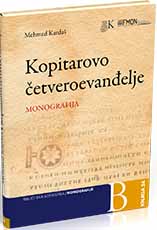
Stored in the National and University Library in Ljubljana under the signature mark Cod. 24, Kopitar’s gospel is one of about thirty preserved texts of the Bosnian Church Slavonic literacy. The codex was written in the second half of the 14th century under the auspices of members of the Bosnian Church, but soon after the fall of the Bosnian Kingdom it was preserved in an Orthodox monastery, where its original appearance was changed by reparations and adjustments to suit the Serbian Orthodox Church liturgy.The philological analysis of this relatively well-preserved codex imposed itself as a research task whose results should provide the most important knowledge about the codex itself and the process of editing its text at all levels of realization, as well as the position of the manuscript in relation to the Church Slavic canonical and the Bosnian group of codices.The entire codex, which is by all features – codicological, graphetic and linguistic – a typical representative of the Bosnian tradition, was more or less carefully written in the Bosnian Cyrillic by one scribe. The majority of medieval Bosnian religious texts were written in the same type of this version of the Cyrillic alphabet, which, along with lapidary and office script,represents a version of the Western Cyrillic script.Orthographic features of Kopitar’s gospel are shown in adhering to the Bosnian spelling tradition, which follows the oldest Old Church Slavic matrix, primarily the Glagolitic script, which is confirmed in the solutions of ambivalent values of individual letters. In addition to their true values, the letter ѣ has the value /ja/; the letter е serves as the value /je/ in the initial and post-vowel position; letters л and н entail the values /ĺ/ and /ń/; whilethe letter jerv only had the value /đ/ for the scribe of Kopitar’s gospel. Aslight distance from the Bosnian spelling tradition can be assumed in amore frequent use of ligature ѥ.The language of Kopitar’s gospel marks the breakthrough of dialectal innovations from the Western Shtokavian base. Besides Ikavian as a distinguishable feature of this literacy which is in Kopitar’s manuscript massively present and most likely indicates the Ikavian organic idiom of the scribe, other western features are also registered in the codex: the reflex/j/ < *dj, and, rarely, the reflection of the group va < vь. Furthermore, in the entire codex, other linguistic features are recorded, which testify about the condition of the Shtokavian speech during the second half of the 14thcentury, such as the vocalization of the semivowel u /a/, the reflex /u/ < vь,etc. Since there are no examples in the codex of changing the final l > /o/which is found in other Bosnian gospels written at the end of the 14th and the beginning of the 15th century, this leads to the conclusion that the time of writing of Kopitar’s manuscript could be moved towards the middle of the 14th century.
More...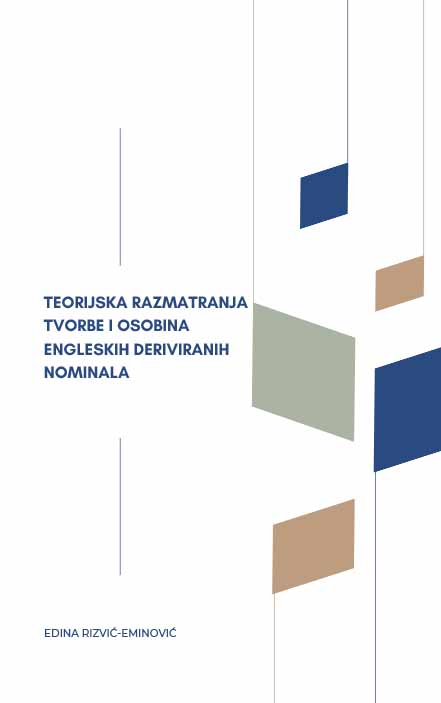
By applying the descriptive analytical method, this book presents the properties of English derived nominals at the phonological, morphological, phrase and functional level. Within the scope of this book, derived nominals are nouns derived from verbs, characterized by the following suffixes: -al (arrival), -ance (-ence) (admittance), -tion (¬-ation, -ition, -ution, -ion, -tion) (destruction), -ment (development), and –ure (closure), which may express event and have aspectual properties and argument structure inherited from the corresponding verb (Rizvić-Eminović, 2014, p. 440). The overview of morphological properties of derived nominals includes the analysis of the limitations associated with their suffixation and incorporates a brief diachronic analysis. Additionally, the suffixation in the case of derived nominals reveals some phonological restrictions related to the nominals and some of the above-mentioned suffixes. At the phrase level, the book presents the properties which derived nominals share with other nouns, but verbs as well, while the functional analysis suggests that nominals may perform the same functions in the sentence as other English nouns. The analysis of the properties of derived nominals presented in the different chapters of the book leads to the conclusion that the suffix itself does not affect the features or the interpretation a derived nominal has. It may also be concluded that the interpretation of a derived nominal as either a process or a result nominal requires that not only the presence or absence of the of phrase should be taken into account, but also its aspectual properties expressed through specific aspectual phrases or adverbials occurring with the derived nominal.
More...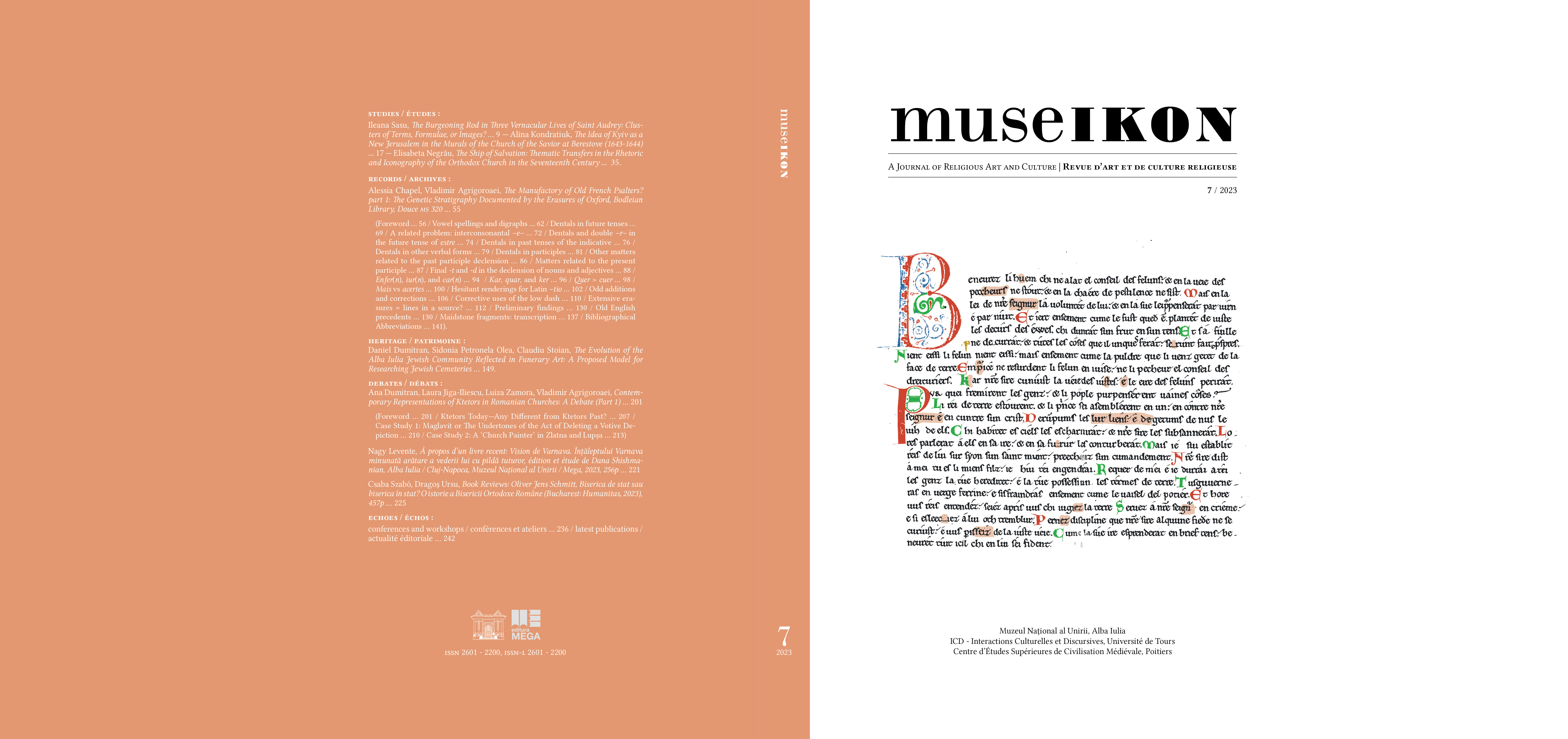
Pentru a înțelege mai bine relațiile intertextuale dintre psaltirile franceze medievale, întoarcerea la o sursă fundamentală precum Psaltirea de la Oxford (manuscrisul Oxford, Biblioteca Bodleiană, Douce 320) este esențială. Astfel, unul dintre scopurile acestui articol este cel de a pune bazele unui studiu al modificărilor de natură textuală reprezentate de numeroase ștersături care reflectă procesul de redactare și spun povestea acestui manuscris. Deoarece studiul este de amploare, a fost necesară segmentarea lui în mai multe publicații. În această primă etapă, după o introducere care analizează relațiile manuscrisului Douce 320 cu alte manuscrise din familia sa (de exemplu, Londra, British Library, Arundel MS 230), autorii discută ștersăturile legate de fluctuația vocalelor și diftongilor în ortografia anumitor cuvinte. Analiza tratamentului dentalelor finale ocupă apoi secțiuni referitoare la anumite forme verbale ale modurilor indicativ, conjunctiv și participiu. Acestea sunt completate de studii privind ștergerea unui -e- interconsonantic în formele de viitor și oscilarea între -r- și dublu -rr- în formele de viitor ale verbului estre. În cele ce urmează, ștersăturile și/sau corecturile legate de dentale permit de asemenea să fie abordată problema declinării, nu numai în cazul participiilor, ci și a mai multor substantive și adjective. Cercetarea se concentrează apoi pe studii de caz: ștergerea unui –n final în enfer(n), iur(n) și car(n); ezitările scribului legate de ortografia conjuncției car; înlocuirea frecventă a lui q cu c în cuvântul quer/cuer; ezitarea între folosirea conjuncției mais sau a conjuncției acertes; precum și multiplele opțiuni de a traduce sufixul latin –tio. O paranteză deschisă cu privire la anumite adăugiri și/sau corecturi sugerează posibilitatea ca manuscrisul Douce 320 să nu fie o traducere autografă a Psaltirii St. Albans (păstrată la Hildesheim, Dombibliothek, St. Godehard 1). Scribul ar fi folosit mai degrabă o sursă latină cu o glosă vernaculară interliniară. Această deducție pare să fie confirmată și de utilizarea unei liniuțe de unire, pe care copistul o folosește pentru a compensa erori probabile de transcriere. Ipoteza aceasta este susținută mai ales de cercetarea asupra câtorva „ștersături lungi”. Ele par a privi unități de transcriere a căror modificare este legată de structura și interconectarea textuală cu o sursă care prezintă atât un text latin, cât și o glosă interliniară. În încheierea acestei părți, după ce au prezentat, spre comparație, exemple preluate din Psaltirea Winchester și Psaltirea Arundel, autorii propun reconstituirea unui segment de text care ar putea fi mai aproape de sursa manuscrisului Douce 320. Articolul se încheie cu o comparație cu precedentele în limba engleză veche și cu o transcriere a fragmentelor de la Maidstone, Centrul și Biblioteca de Istorie Kent, Fa/Z1 (fragmentul Faversham i). Continuarea cercetării este prevăzută pentru următorul număr al revistei Museikon.
More...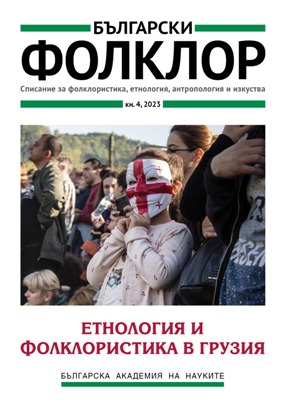
Artanuji, the oldest city of Klarjeti, historical Georgia, is within the boundaries of Turkey on the grounds of Kars Treaty (1921). According to the data, gathered through the fieldwork in 2010‒2014, ethnic Georgians were exiled from Artanuji after the World War II. The article deals with the written sources and field data, providing detailed information about the Artanuji population, ethnic Christian Georgians as well as Muslim Georgians. The historical past in this region reminds of itself through the toponyms that appeared in the places of historical Georgia and through the speech of population and covers the history of the ethnic groups. The toponyms attested on the territory of historical Georgia have a great importance for they shed light on a certain period of history and are the only witnesses of Georgian settlement here.
More...
The article briefly evaluates the vast literature relating to the worship of St. George in Georgia and draws on the ethnographic data collected by the author in the years 1977 to 1987. It explores the worship of St George in the Caucasus Georgia both in the past and present. Consequently, it discusses such categories as religious practice, belonging to the parish and territory, identity and, sharing holy places, epithets of the Saint, hybrid cults, etc. The materials used are: written historical sources, ethnographic data attested in the writings of Christian Missionaries (Christopher Castelli, Jean Chardin, Arcangelo Lamberti, etc.), the ethnographic data gathered (during 2018-19) among Internally displaced persons, and contemporary emic and etic researches undertaken by anthropologists of the 20th and 21st centuries. The argument of the present contribution is based upon a series of ethnographic observances that present traditional feasts of the saint and their transformations in the light of current political processes. Accordingly, detailed ethnographic field data and observations are contextualized in time and space, using the explorations and studies of anthropologists and historians. The article tries to show how once traditional Christian site (lieux de mémoire in Pierre Nora’s sense) with its real environment and with is firm identity is deterritorialized and transformed into a shared place of mixed and ambiguous pilgrimage place through the political processes and hybridization.
More...
Georgian everyday life is highly tied up with the rich religious traditions that have been developed as a result of the centuries-long synthesis of pre-Christian and Christian practices and worldviews. The Soviet period caused the fragmentation of the traditional religious knowledge and the practice moved to the household level and was paganized. In the post-Soviet period, the burst of religious sentiments and search for identity increased the involvement of big masses to religious practices. The transformations were accompanied by a process of individualization of religion, which has led to a change of forms of religiosity. Based on the ethnographic data of East Georgia, the article discusses the correlation of the normative, vernacular and resistant forms of religiosity. Historical-comparative and parallel analyses are used to research two examples of religious practice: Lomisoba and Berikaoba. Lomisoba is analyzed as an example of hybrid, massive, collective holiday. Berikaoba is more local, not connected to a sacred site, performative festival. It is argued that the contemporary processes are having an impact on the religiosity and the religiosity of certain groups is trying to be defined in new forms. All the old and new forms of religiosity are explicitly displayed and played out in contemporary Georgia. At the same time there are some hidden, or rather implicit practices.
More...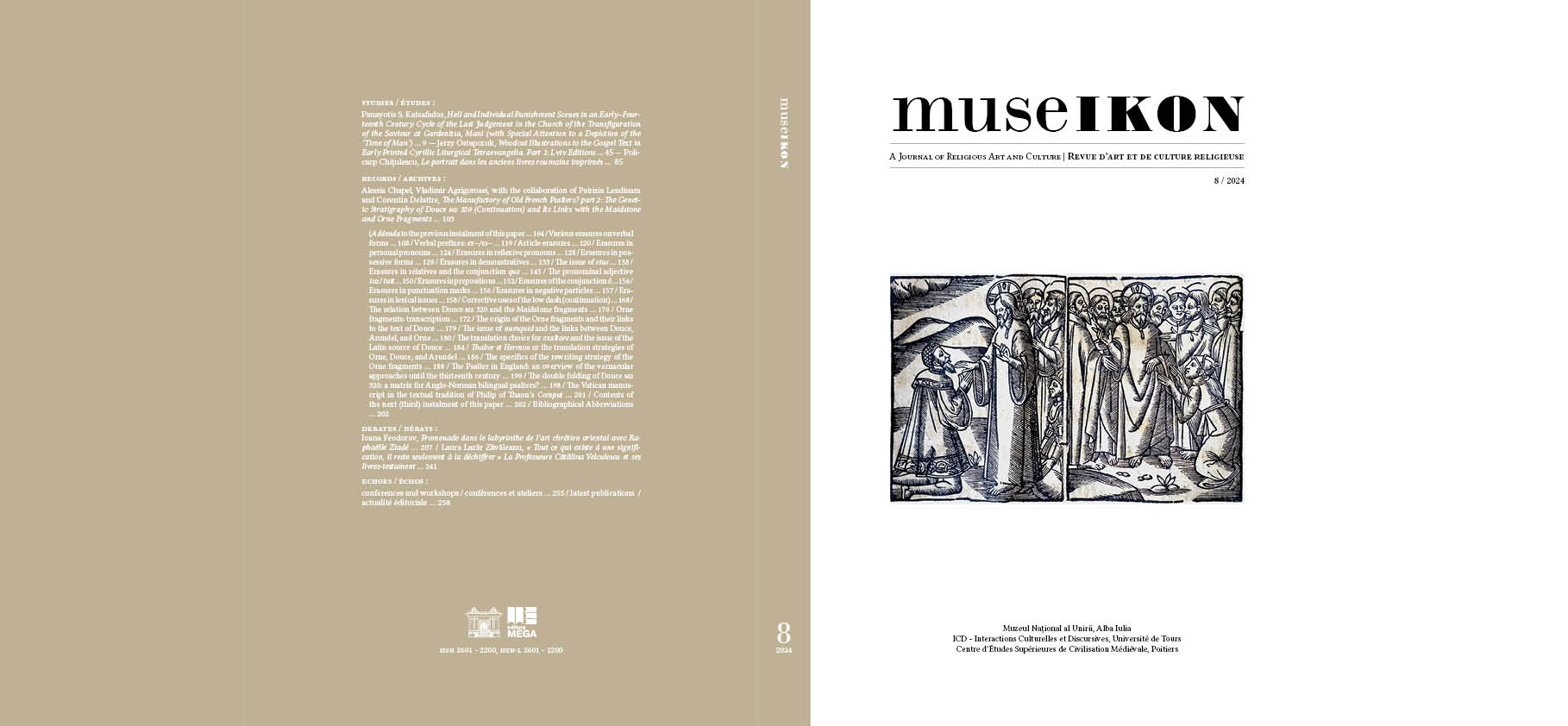
The painted, engraved, or sculpted portrait is an attempt to immortalize a person and preserve their memory. Often, portraits served both didactic and aesthetic purposes, particularly in religious texts. In Orthodox books, portraits typically depicted saints rather than individuals contemporary with the time of the book's publication. It is exceedingly rare for an Orthodox book to include the portrait of a person who was alive at the time of publication or who had passed away relatively close to that date. While the practice of including portraits of individuals associated with a book was common in the West, it is a notable exception in the history of Romanian engraving and printing tradition. In this study, we have sought to identify the individuals and volumes printed in the Romanian Lands up to the nineteenth century in which such portraits appeared. We have also examined the motivations behind the inclusion of these portraits, whether engraved in wood or brass. This research was inspired by the portraits of Elder Paisios of Neamţ († 1794), printed in books by his disciples. We will analyze these representations of the great hesychast and then explore several other portraits we have identified in Romanian books thus far.
More...